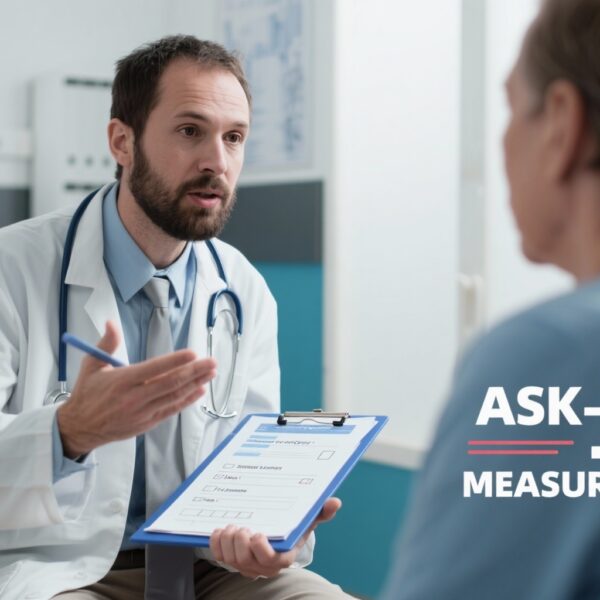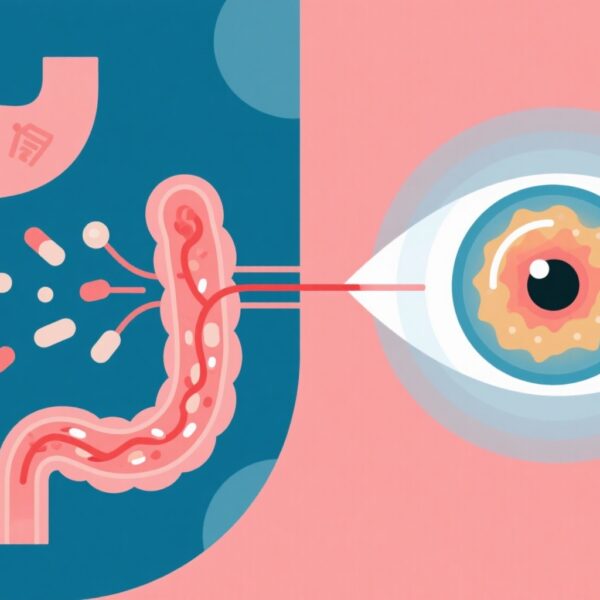Highlight
– In the ENLIGHT UC (ES101002) phase 3 trial, once-daily oral etrasimod 2 mg produced significantly higher clinical remission vs placebo at induction week 12 (25.0% vs 5.4%; adjusted difference 20.4%, p<0.0001) in East Asian patients with moderately to severely active ulcerative colitis (UC).
– Among induction responders re-randomized to maintenance, etrasimod maintained remission at week 40 more frequently than placebo (48.1% vs 12.5%; adjusted difference 35.9%, p<0.0001), yielding a maintenance NNT of approximately 3.
– Safety findings were generally favorable, with most adverse events mild to moderate; the most frequent induction TEAE with etrasimod was ALT elevation (10% vs 1% for placebo), supporting the need for liver-function monitoring.
Background and Clinical Context
Ulcerative colitis (UC) is a chronic inflammatory condition of the colon characterized by relapsing mucosal inflammation causing diarrhea, rectal bleeding, and impaired quality of life. Moderate–severe UC often requires systemic therapy beyond mesalamine, including corticosteroids, immunomodulators, biologics, and small molecules. Despite multiple therapeutic classes, many patients have inadequate response or intolerance to existing agents, and oral, once-daily alternatives with favorable safety profiles remain clinically attractive.
Etrasimod is an oral sphingosine 1-phosphate (S1P) receptor modulator that reduces lymphocyte egress from lymphoid tissues to the circulation, thereby decreasing inflammatory cell trafficking to the gut mucosa. Prior studies have suggested efficacy in UC, and ENLIGHT UC (ES101002) sought to confirm efficacy and safety specifically in an East Asian population across induction and maintenance treatment phases.
Study Design
ENLIGHT UC was a randomized, double-blind, placebo-controlled, multicentre phase 3 trial conducted at 52 hospitals in China, Taiwan, and South Korea (ClinicalTrials.gov NCT04176588). Key inclusion criteria were adults 18–75 years with moderately to severely active UC (modified Mayo score [MMS] 4–9, endoscopic subscore ≥2, rectal bleeding subscore ≥1) and prior inadequate response or intolerance to at least one UC treatment.
In the 12-week induction period, 340 patients were randomized 2:1 to etrasimod 2 mg once daily (n=228) or placebo (n=112), with randomization stratified by previous treatment and baseline disease activity. Patients who achieved an MMS clinical response at week 12 were re-randomized 1:1 to etrasimod 2 mg or placebo for a 40-week maintenance period; maintenance randomization was stratified by induction treatment, prior exposure to biologics or JAK inhibitors, and corticosteroid use at induction baseline. The primary efficacy outcome for both periods was MMS clinical remission (stool frequency subscore 0, or 1 with ≥1 point decrease; rectal bleeding subscore 0; endoscopic subscore ≤1, excluding friability), assessed at induction week 12 and maintenance week 40. Analyses used the full analysis set (FAS) of patients who received at least one dose in each period; safety analyses used the safety analysis set (SAF).
Key Results
Enrollment and disposition: 606 patients were screened between Sept 25, 2019 and April 27, 2023. The induction FAS included 228 patients assigned to etrasimod (88 female, 140 male) and 112 assigned to placebo (44 female, 68 male). Of the induction responders, 157 entered maintenance and comprised the maintenance FAS (77 etrasimod: 35 female, 42 male; 80 placebo: 32 female, 48 male).
Efficacy — Induction (week 12)
Clinical remission at induction week 12 occurred in 57 of 228 etrasimod-treated patients (25.0%) versus 6 of 112 placebo-treated patients (5.4%). The adjusted difference was 20.4% (95% CI 13.4%–27.4%; p < 0.0001). This is a clinically meaningful absolute benefit; using the reported adjusted difference, the approximate number needed to treat (NNT) for one additional remission at week 12 is about 5 (1/0.204 ≈ 4.9).
These results indicate a robust induction signal in a population enriched for previous therapy failure or intolerance, and across the prespecified stratification factors.
Efficacy — Maintenance (week 40)
In patients who responded to induction and were re-randomized, maintenance remission at week 40 was achieved in 37 of 77 (48.1%) etrasimod recipients versus 10 of 80 (12.5%) placebo recipients. The adjusted difference was 35.9% (95% CI 22.5%–49.2%; p < 0.0001). The NNT to maintain remission among induction responders is approximately 3 (1/0.359 ≈ 2.8), indicating a large maintenance treatment effect in this selected responder cohort.
Other efficacy considerations
The trial’s primary analyses focused on clinical remission by MMS criteria; the publication reports these as the primary endpoints for both induction and maintenance. Because maintenance randomization included only induction responders, the maintenance results apply to the subset of patients with an initial clinical response; this is typical for UC maintenance trials but should be considered when translating results to broader clinical populations.
Safety
Overall, etrasimod was well tolerated in both induction and maintenance periods, with most treatment-emergent adverse events (TEAEs) rated mild or moderate.
Induction period
The most frequently reported TEAE during induction with etrasimod was increased alanine aminotransferase (ALT): 22 of 228 patients (10%) on etrasimod versus 1 of 112 patients (1%) on placebo. Discontinuation rates due to TEAEs during induction were low: five (2%) of 228 on etrasimod and four (4%) of 112 on placebo. There were no grade 4 or higher TEAEs, no malignancies, and no deaths reported in the induction period.
Maintenance period
The most frequent TEAE during maintenance was upper respiratory tract infection (URTI): 14 of 77 patients (18%) on etrasimod and 14 of 80 patients (17%) on placebo. One (1%) of 77 etrasimod-treated and one (1%) of 81 placebo-treated patients discontinued due to TEAEs during maintenance. Across periods, events leading to discontinuation were uncommon. No grade 4 or higher TEAEs, malignancies, or deaths were reported.
Class-relevant safety signals and monitoring implications
S1P receptor modulators have known class-associated risks including transient bradycardia at initiation, rare macular edema, infection risk including herpesvirus reactivation, and liver-enzyme elevations. The ENLIGHT UC publication highlights ALT elevation as the most common TEAE with etrasimod in induction, which reinforces the need for baseline and periodic hepatic transaminase monitoring. The trial did not report serious cardiac conduction events, macular edema, malignancies, or deaths, but clinicians should remain vigilant and follow label guidance for first-dose observation and screening where applicable.
Expert Commentary and Interpretation
ENLIGHT UC provides high-quality evidence supporting etrasimod 2 mg once daily as an effective oral option for induction and maintenance of remission in moderately to severely active UC in East Asian populations. The statistically and clinically significant induction and maintenance effects, combined with low overall discontinuation rates and absence of severe adverse events in this trial, position etrasimod as a meaningful addition to the therapeutic armamentarium.
Strengths
Key strengths include randomized, double-blind design; adequate sample size for induction; clinically relevant and prespecified endpoints; and a maintenance phase capturing durability among responders. Conducting the trial across multiple centers in China, Taiwan, and South Korea provides robust region-specific data and addresses potential ethnic or pharmacogenomic differences in efficacy or safety.
Limitations and generalizability
Several limitations warrant consideration. First, the maintenance phase included only induction responders, so maintenance efficacy applies to that selected population and does not inform outcomes for non-responders. Second, the study population was limited to East Asia; while this is a strength for regional data, generalizability to other ancestries may require corroboration from broader international trials. Third, the trial report emphasizes elevated ALT as a common TEAE but does not provide granular data in this summary regarding the magnitude of enzyme elevations, time course, or rechallenge outcomes; such details influence monitoring recommendations. Finally, long-term safety beyond 52 weeks and rare adverse events (e.g., opportunistic infections, malignancy risk) require continued pharmacovigilance and real-world data.
Place in therapy
Etrasimod offers an oral, once-daily alternative for patients with moderate–severe UC who have inadequate response or intolerance to existing therapies. Its convenience and the magnitude of effect—particularly for maintenance among induction responders—suggest it could be considered alongside biologics and JAK inhibitors, taking into account patient preference, prior therapy exposure, comorbidity profile, and safety monitoring requirements (especially hepatic monitoring and infection risk assessment).
Conclusion
The ENLIGHT UC phase 3 trial demonstrates that etrasimod 2 mg once daily achieves clinically meaningful induction and maintenance remission rates versus placebo in East Asian patients with moderately to severely active UC, with an acceptable tolerability profile. The most notable safety signal in this dataset was ALT elevation during induction, underscoring the importance of liver-function monitoring. These findings support etrasimod as a valuable oral option in the treatment algorithm for UC, while ongoing long-term and real-world surveillance will be important to fully characterize rare or late-emerging risks.
Funding and registration
Funding: Everest Medicines.
Trial registration: ClinicalTrials.gov NCT04176588.
Reference
Wu K, Zheng C, Cao Q, Ding Y, Gao X, Zhong J, Chiu CT, Zhang H, Wang X, Wang B, Liang J, Liu X, Zhou Y, Xu B, Kim TO, Shen X, Chen D, Chen W, Liu Y, Shen J, Liu F, Ding X, Zhan Q, Chou JW, Zeng S, Lin Y, Ying L, Chen X; ENLIGHT UC Study Group. Etrasimod as induction and maintenance treatment for patients with moderately to severely active ulcerative colitis in East Asia (ENLIGHT UC): a randomised, double-blind, placebo-controlled, multicentre, phase 3 study. Lancet Gastroenterol Hepatol. 2025 Dec;10(12):1089-1103. doi: 10.1016/S2468-1253(25)00198-0. Epub 2025 Sep 30. PMID: 41043449.
AI-friendly thumbnail prompt
A professional clinical-science illustration: an outpatient clinic scene with an East Asian male and female patient reviewing a tablet with a gastroenterologist, overlaid by a molecular schematic of a sphingosine-1-phosphate receptor and an abstract colon silhouette; cool clinical colors, high detail, balanced composition.



